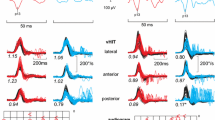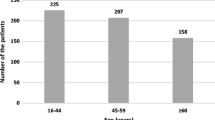Abstract
The aim of this study was to investigate the characteristic of hypotensive patients with vertigo. Twenty hypotensive patients with rotatory vertigo, 15 hypotensive subjects without vertigo, and 15 mitral valve prolapse subjects without vertigo underwent a battery of tests including audiometry, electronystagmography (ENG), and vestibular evoked myogenic potential (VEMP) test. The abnormal rates in terms of audiometry, eye tracking, optokinetic nystagmus, visual suppression, and caloric tests were 15, 35, 35, 10, and 42% for the first group; 13, 20, 33, 0, and 0% for the second group; and 7, 13, 60, 0, and 3% for the third group, respectively. Comparison of the first group with the other two control groups revealed that significant difference existed only in the abnormality of caloric responses. Fifteen (75%) of 20 hypotensive patients with vertigo having abnormal ENG results, asymmetric caloric responses, or delayed VEMPs were attributed to vertigo of central origin, possibly from ischemic disorder. In contrast, five patients (25%) had neither central signs in ENG nor abnormal VEMPs, but showing bilateral normal or hyperactive caloric responses were classified as autonomic dysfunction. After 3 months of medication, all patients with autonomic dysfunction had their vertigo and autonomic symptoms subsided, whereas 27% of the patients with ischemic disorder had vertigo persisted, showing a significant difference. In conclusion, hypotensive patients with vertigo could be due to either direct autonomic dysfunction or ischemic disorder mediated by autonomic deficits.
Similar content being viewed by others
References
Pappas DG Jr (2003) Autonomic related vertigo. Laryngoscope 113:1658–1671
Pirodda A, Brandolini C, Modugno GC (2004) Hypotension associated with autonomic dysfunction: a possible cause of vertigo? Med Hypothesis 63:1086
Matsunaga T, Tamamoto K, Kubo T (1985) Directional preponderance of nystagmus and excitement of autonomic nervous system. Acta Otolaryngol 99:459–465
Ohashi N, Yasumura S, Nakagawa H, Shojaku H, Mizukoshi K (1991) Cerebral autoregulation in patients with orthostatic hypotension. Ann Otol Rhinol Laryngol 100:841–844
Grubb BP, Karas B (1999) Clinical disorders of the autonomic nervous system associated with orthostatic intolerance: an overview of classification, clinical evaluation, and management. Pacing Clin Electrophysiol 22:798–810
Wang SJ, Young Y-H (2003) Vestibular evoked myogenic potentials using simultaneous binaural acoustic stimulation. Hear Res 185:43–48
Perloff JK, Child JS, Edwards JE (1986) New guidelines for the clinical diagnosis of mitral valve prolapse. Am J Cardiol 57:1124–1129
Kantos HA, Wei EP, Navari RM, Levasseur JA, Rosenblum WI, Patterson AL (1978) Responses of cerebral arteries and arterioles to acute hypotension. Am J Physiol 234:H371–H383
Ito F, Tanaka K, Kamada H (1998) Vertigo secondary to hypotension: the relationship between therapeutic effects and hearing. Auris Nasus Larynx 25:161–167
Pirodda A, Ferri GG, Modugno GC, Gaddi A (1999) Hypotension and sensorineural hearing loss: a possible correlation. Acta Otolaryngol 119:758–762
Young Y-H, Nomura Y (1995) Vestibular changes after guinea pig cytomegalovirus infection. Acta Otolaryngol Suppl 520:157–159
Precht W, Shimazu H, Markham CH (1966) A mechanism of central compensation of vestibular function following hemilabyrinthectomy. J Neurophysiol 29:996–1010
Yang TL, Young Y-H (2004) Radiation-induced otitis media—study by a new test, vestibular evoked myogenic potential. Int J Radiat Oncol Biol Phys 60:295–301
Weissman NJ, Shear MK, Kramer-Fox R (1987) Contrasting patterns of autonomic dysfunction in patients with mitral valve prolapse and panic attacks. Am J Med 82:880–888
Coghlan HC, Phares P, Cowley M (1979) Dysautonomia in mitral valve prolapse. Am J Med 67:236–244
Crampton GH, Young FA (1953) The differential effects of a rotary visual field on susceptibles and nonsusceptibles to motion sickness. J Comp Physiol Psychol 46:451–453
Acknowledgement
This work was supported by a grant from the National Science Council, Taipei, Taiwan (Grant No. NSC 94-2314-B002-239).
Author information
Authors and Affiliations
Corresponding author
Rights and permissions
About this article
Cite this article
Yang, CS., Young, YH. Clinical investigation on hypotensive patients with vertigo. Eur Arch Otorhinolaryngol 263, 804–808 (2006). https://doi.org/10.1007/s00405-006-0072-4
Received:
Accepted:
Published:
Issue Date:
DOI: https://doi.org/10.1007/s00405-006-0072-4




